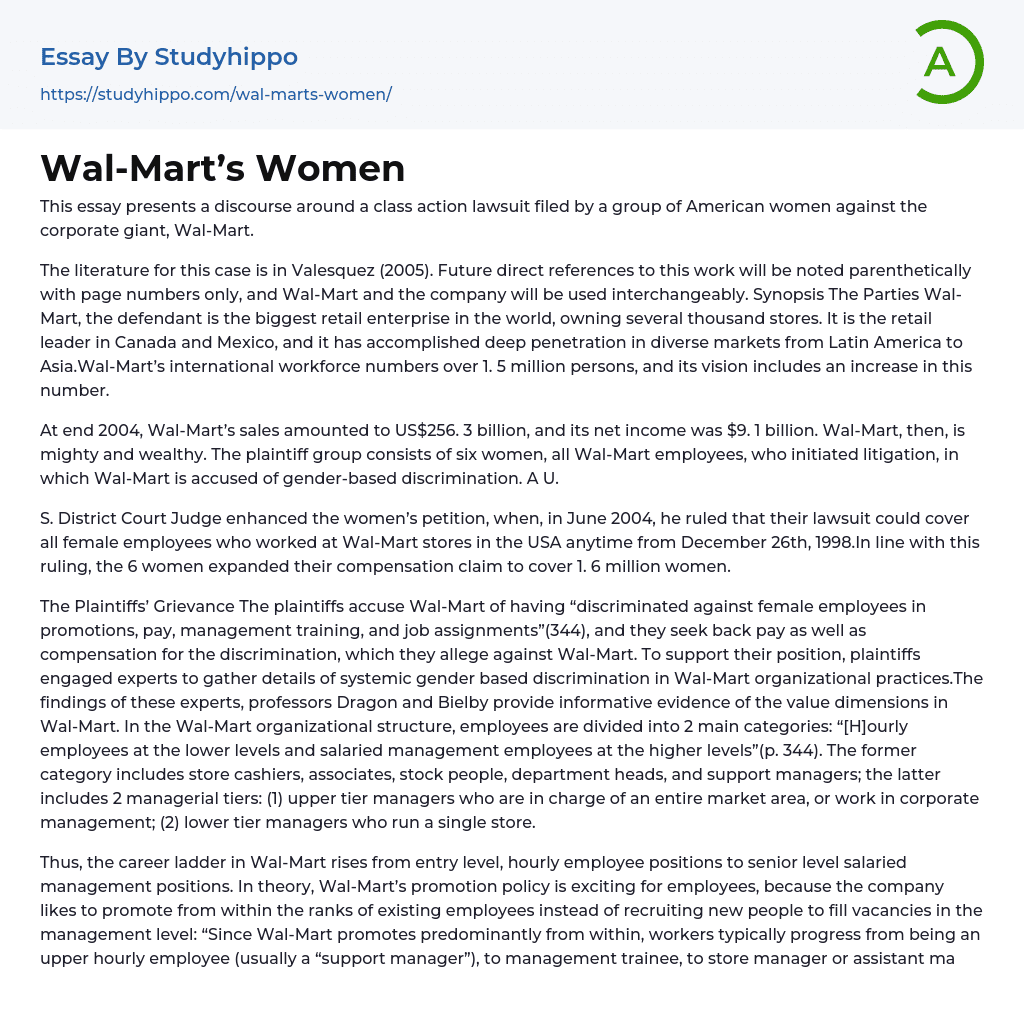The focal point of this composition is a discussion regarding the legal action taken by a cohort of female citizens in the United States against the major corporation, Wal-Mart.
In his work from 2005, Valesquez discusses the case of Wal-Mart, also referred to as "the company". The literature cites page numbers (in parentheses) and identifies Wal-Mart as the defendant. This retail giant is recognized as the largest global company in its field with a strong market presence in Canada, Mexico, Asia, Latin America and other international markets. Currently boasting over 1.5 million employees worldwide, Wal-Mart has plans to further expand its workforce in line with its vision.
Wal-Mart achieved sales of $256.3 billion and a net income of $9.1 billion by the end of 2004, establishing itself as a successful corporation. Nevertheless, six female workers at Wal-Mart sued the company claiming it engaged in gen
...der discrimination.
In June 2004, the petition of female employees at Wal-Mart stores in the USA was extended by a S. District Court Judge. This allowed the lawsuit to include all women who worked there from December 26th, 1998. As a result, the 6 women behind the petition broadened their compensation claim to encompass 1.6 million women. The text is enclosed in a HTML paragraph tag.The Plaintiffs allege that Wal-Mart discriminated against female employees in promotions, pay, management training, and job assignments, seeking back pay and compensation. They employed experts to collect information on Wal-Mart's organizational practices and found evidence of systemic gender-based discrimination. Professors Dragon and Bielby's findings provided valuable insights into the value dimensions in Wal-Mart. The company structure divides employees into two categories: hourly workers at lower levels and salaried managemen
employees at higher levels. The lower category includes cashiers, associates, stock people, department heads, and support managers, while the upper tier managers are in charge of an entire market area or work in corporate management. The second managerial tier comprises lower-tier managers who run individual stores.
Wal-Mart's career ladder spans from entry level, hourly positions to senior salaried management roles, with an exciting promotion policy that prefers existing employees over external hires: "Since Wal-Mart promotes predominantly from within, workers typically progress from being an upper hourly employee (usually a 'support manager'), to management trainee, to store manager or assistant manager, and finally to district, regional, or corporate manager" (p. 345). However, the dominance of certain employee groups in this pathway brings up concerns about employment equity within the company.
Wal-Mart employees value promotion due to prestige, responsibility, and rewards, as noted by the pay discrepancy between salaried managers and hourly employees in 2001. Women make up the majority of lower level hourly employees but have limited representation in upper level management. Despite women being a major group in the beginning stages of the Wal-Mart career ladder, men hold a disproportionate amount of managerial positions.
The promotion rates of women at Wal-Mart have been inconsistent with their representation at lower levels, as reported by one plaintiffs' investigator. The "feeder pools" that supply candidates for promotion have seen a disparity in promotion rates: "Women received 2,891 fewer promotions into Support Manager [the step before Management Trainee].... Women received 2,952 fewer promotions into Management Trainee.... Women received 346 fewer promotions into Co-Manager.... Women received 155 fewer promotions into Store Manager...." (p. 346).
The issue of women being underrepresented in corporate
management is exemplified by Wal-Mart and results in gender-based power imbalances within organizations. Additionally, evidence suggests that women at Wal-Mart experience pay inequity, as they are paid less than men for comparable work even after considering factors such as seniority, status, and store location. These findings bolster the plaintiffs' legal challenge against Wal-Mart.
In essence, Wal-Mart is facing a significant danger from the plaintiffs’ legal action and thus needs to prioritize both its internal and external strategies. Specifically, the company must examine its regulations and, critically, its actions regarding the welfare of its workforce, while also implementing measures to safeguard its market position and financial performance. Subsequently, the following section will analyze the plaintiffs’ lawsuit as a potential hazard for Wal-Mart.
- American Dream essays
- Barriers To Entry essays
- Capitalism essays
- Central Bank essays
- Compensation essays
- Consumerism essays
- Economic Development essays
- Economic Growth essays
- Economic Inequality essays
- Economic System essays
- Economy essays
- Employment essays
- Export essays
- Finance essays
- Free Trade essays
- Gross Domestic Product essays
- Human Development essays
- Income Inequality essays
- Industry essays
- Inflation essays
- International Business essays
- International Trade essays
- Macroeconomics essays
- Materialism essays
- Max Weber essays
- Microeconomics essays
- Minimum Wage essays
- Monetary Policy essays
- Monopoly essays
- Pricing essays
- Profit essays
- Recession essays
- resources essays
- Taxation essays
- Trade essays
- Unemployment essays
- Warehouse essays
- World economy essays
- Agreement essays
- Business Law essays
- Common Law essays
- Community Policing essays
- Constitution essays
- Consumer Protection essays
- Contract essays
- Contract Law essays
- Copyright Infringement essays
- Court essays
- Crime essays
- Criminal Law essays




